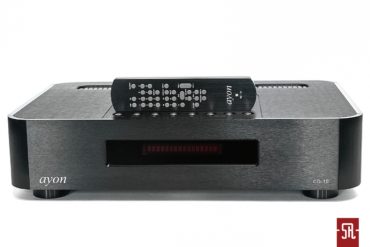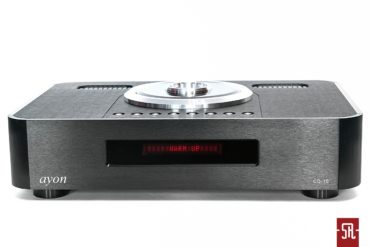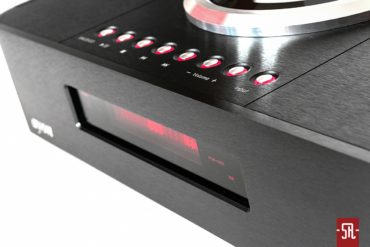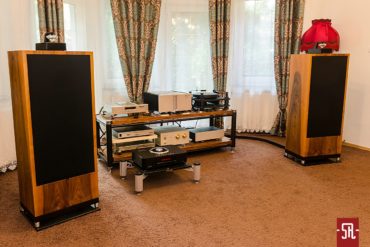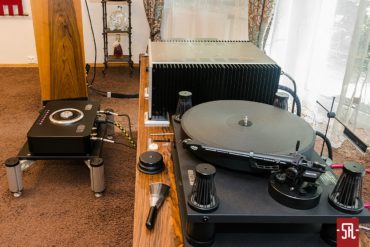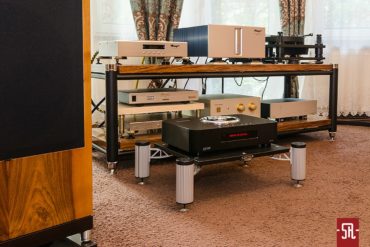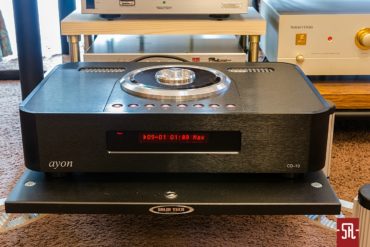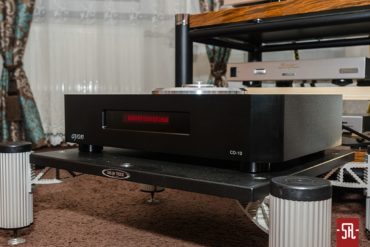Ayon Audio CD-10 SoundRebels Review

AYON CD-10 ENGLISH VER.

Opinion 1
Like Mark Twain used to say, the rumors that the CD is dead are vastly exaggerated. After first hype about the files, and the return of the vinyl, it turned out, that there is also place for the silver disc. But to draw such conclusions you did not only need to watch the market closely, but also work hard in the meantime, to have something for your customers to buy during awakening. Currently we can split the manufacturers into those, who are doing just what they did – like Accuphase, those who dropped the idea of the CD, and are marginalizing themselves, what was best shown by Linn, and finally those, who can draw profit from both parts of the market, like Naim, and the hero of our test, the Austrian Ayon. If you start to think now, what novelty Gerhard Hirt has come up with, then I will briefly explain, that he accumulated his portfolio a bit, while bringing it to a higher level, as he exchanged the popular models 07s and 1sx for one new construction, called CD-10, which we will test now.
Moving to the external description paragraph, again, I cannot come around the thought, that everybody sees how it looks like. The Austrian CD players are similar to each other like identical twins. This time we have a perfect reproduction of the looks of the 1sx, even at the level of the smallest details. Exactly the same size, weight and chassis, the same display (at least when it is powered off) placed in the center of the fascia, the same row of navigational buttons surrounded with red light rings and the bullseye drive on top, with the heavy acrylic cover. Only the back plate has a few, rather insignificant changes, brought by the irrational addiction to safety of European bureaucrats. Please imagine, that for EU safety people, the red LED indicating proper polarization of the power cord was something deadly unsafe, as when you smash it (using a sledgehammer for example) this could result in the person operating the hammer to be electrocuted. Following this trail, they should rather prohibit the usage and sale of hammers, as those can hurt people, if you aim them wrongly. This is really something.
Fortunately, all the other sockets and switches did pass the Brussels sieve, so when we decide to own the 10, we will have line inputs in RCA and XLR standards, a set of digital inputs in the form of a coaxial, optical and USB ports, there is also a coaxial output, if you would wish to connect a digital recorder or DAC to the unit. There are also the switches used to set the amplification, output and operating modes.
According to official communiques of the manufacturer, the price and chronology the CD-10 is a successor to the CD-1sx model, but it does also use solutions applied in the flag model CD-35. So how this mixture work? Quite convincing I must say, as logic would tell us this model is an evolution of the CD-1sx platform, while used technology shows the CD-10 as the CD-35 “younger” brother. Don’t you believe me? There is proof for that. The digital to analog conversion is done in 10 using the same AKM 4490 DAC chip as in the flag model, which has a 32 bit 768 kHz resolution and also handles DSD256 signals natively. The difference is, that in the 35 there were two chips applied, while in the 10 only one is used. Of course its implementation required a significant rework of the digital section “borrowed” from the 1sx, which was based on the ESS 9018 chip. However there are elements of the puzzle, which work well for years now, so there was no need to modify them on this level. So in the output stage we will find the 6H30 triodes and the single 6Z4 (6C4P) in the power supply.
So how does this combination of new with the old fare sonic wise? Without too much ado, I will say … it was surprising. It cannot be denied, that during the last years Ayon worked out their own “sound school”, combining out of the ordinary dynamics and resolution of the “dense” formats with saturation and juiciness attributed to the tubes employed in the output stage. A very palpable confirmation of the said definition was the CD-35, which debuted at the end of last year, which turned out to be deadly contender for the competition, as paying more for players which did not sound better, but only matched the performance of the Austrian device, would be perceived as extravagance and quirk. Yet, the CD-10 shows a more lyrical and old-school side of the silver discs. You could say, that using the newest technologies, it cultivates the sound aesthetics of the TDA 1541 chips. Yes, dear Readers, no one else but Ayon, in its newest player, decided to revive the feeling of vinyl-like intimacy and joy coming from listening to music provided in this way. So we have homogeneity, almost indecent saturation and euphony, things, you might think, other manufacturers forgot about. In this way, playing practically every disc, we become overwhelmed with the musicality, delightful and addictive, which moves us from the level of critical listening to indiscriminate joy of listening. Instead of concentrating on nuances and splitting of the sound into atoms, we put on the hedonist pleasure of following the melodic line and enchanting vocals. Surprisingly, when we push ourselves to coldly look at the sound reproduced by the newest Ayon player, we still have splendid resolution, gradation of planes and focusing of the virtual sources, but those elements were put together in a different way than it was the case before. This time the midrange plays the most important role, and similar to what was happening with the very musical 07, also in the newest player, the extremes of the sound spectrum accompany it, amending the midrange. And it does not mean, that the treble is veiled, or that the bass is of “bookshelf speaker” kind, but from the first notes you can hear, that those are not most important here. To see this, you do not need to search for any special, audiophile samplers. The Leonard Cohen epitaph, “You Want it Darker” is absolutely sufficient, the vocal of the late singer is presented so close and intensive, that even drinking tea during listening seems to be out of place. It is very dense, organic and analog, similar to how the mentioned TDA 1541 sounded. The emotions are key, and they make the show. This is not just reproduction, this is something much more palpable – we are part of the event. So we stop worrying about the format, date of issue, or “density” of the source material, we just use our intuition and heart in our musical searches.
Even the seemingly inhumane and cacophonic “Rust in Peace” Megadeth showed its, unknown to date, lyrical face with nicely lowered center of gravity, and with communicative, yet somehow toned down treble. There was no more of the irritating ticking and cymbals sounding like they were made from scrap metal by a home-brew handyman. Their parts were fuller, more saturated, and at the same time they were a bit shortened, well … on this level, there is always one thing for another, although I must say, that the compromise achieved by the manufacturer will probably satisfy a vast array of customers.
It is also worth mentioning, that the available filters, as well as upsampling (in the Signature version) to DSD work a bit softer and with more finesse than in CD-35, where activation of the upsampling is like going from warp 1 to warp 6 in Star Trek – where warp 1 is equal to light speed, while warp 6 is 392 times as fast. Here everything is toned down, softer and fluid.
So for whom is the Ayon CD-10? Against appearances not for the lovers of digital media, trying to have more and more resolution and detail, but it is for all those people, who have thousands or tenths of thousands of CDs, and want to gain the option of using files, via the USB port, or SACDs, while not losing the basic CD playing capability. Due to this move, Gerhard Hirt can gain more followers, from music lovers, who treat all novelties like something interesting, but not the main aspect of what they want, while still being able to use them relatively effortlessly. The CD-10 shows, that those are not so difficult to use, and you can use those for intensification and help while listening to music, what results in only positive impressions.
Marcin Olszewski
System used in this test:
– CD/DAC: Ayon CD-35; Audionet Planck
– Digital player: Lenovo Z70-80 i7/16GB RAM/240GB SSD + JRiver Media Center 22 + TIDAL HiFi + JPLAY; Yamaha WXAD-10
– Digital source selector: Audio Authority 1177
– Turntable: Kuzma Stabi S + Kuzma Stogi + Shelter 201
– Phonostage: Tellurium Q Iridium MM/MC Phono Pre Amp
– Integrated amplifier: Electrocompaniet ECI5; Audionet Watt
– Loudspeakers: Gauder Akustik Arcona 80 + spike extenders
– IC RCA: Tellurium Q Silver Diamond
– IC XLR: LessLoss Anchorwave; Organic Audio; Amare Musica
– Digital IC: Fadel art DigiLitz; Harmonic Technology Cyberlink Copper; Apogee Wyde Eye; Monster Cable Interlink LightSpeed 200
– USB cables: Wireworld Starlight; Goldenote Firenze Silver
– Speaker Cables: Organic Audio; Signal Projects Hydra
– Power Cables: Furutech FP-3TS762 / FI-28R / FI-E38R; Organic Audio Power; Acoustic Zen Gargantua II
– Power distribution board: Furutech e-TP60ER + Furutech FP-3TS762 / Fi-50 NCF(R) /FI-50M NCF(R)
– Wall Socket: Furutech FT-SWS(R)
– Antivibration platform: Franc Audio Accessories Wood Block Slim Platform
– Ethernet cables: Neyton CAT7+
– Table: Rogoz Audio 4SM3
– Accessories: Sevenrods Dust-caps; Furutech CF-080 Damping Ring; Albat Revolution Loudspeaker Chips
Opinion 2
You may say what you want, but in contrast to some opinions, appearing on internet forums, the hero of the test, a product from Ayon Audio, is known amongst music lovers in three ways. First of all, a lot of people amongst lovers of good sound, confirms the high quality of sound produced by Ayon. Secondly, due to the contemporary design, which should fit almost all interiors, the brand is immediately recognizable from the first look. And thirdly, Gerhard Hirt does not just make small changes to already known, and well received products, but he is working hard, all the time, to create better and better products. And due to this work, we are able to showcase on our pages new products very often. And as this happens so often, I will not talk about the history of the brand (as you know it by heart) but will jump immediately to the main thing – the new version of the not so expensive CD and SACD player, which can also function as a DAC, called CD-10, and was supplied for testing by the Polish distributor Nautilus.
I think I do need to tell, how Ayon looks like, so I will do it very briefly. Starting from the chassis, we have a very solid, quite flat box, with rounded edges, finished in brushed aluminum. An important information for all potential users is, that similar to all its predecessors, the tested device is a top-loader, what limits the usage of low shelves in your rack. Writing about the front, I must tell, that there is only a red display there, as well as the company logo and model name. Going to the back, we have on top the opening for loading the discs, covered by a round, acrylic cover, while more to the front, there is a line of eight function buttons present. On the back, besides the typical XLR/RCA outputs, there are also digital connections: Coaxial, Optical and USB. But this is not all, there is also an IEC power socket and three switches, which allow us to select the gain, analog output selection as well as activation of the preamplifier mode. The final information would be about the location of the main power switch – on the bottom of the player, close to the front left foot.
What do you think, what did the CD-10 offer in terms of sound? You might be surprised, as it was quite a lot, and only your preference will decide it this goes for the good or for the bad. So what am I talking about? The Austrian brand steps a bit away from the way of very precise drawing of virtual sources, it had for years, and which was regarded by many as the player playing too offensively. The newest source is drifting towards musicality, probably expected by some people. This is so visible, that for the first time, while playing with a device from this manufacturer, I drowned in music without looking into its deepest secrets and without splitting the sound into basic items. I just put a disc with my beloved ancient music into the player, and tasted the reality of the church music. No vocalization or timbre of instruments could throw me off the following of the melodic line. Also when I deliberately decided to move away, then it turned out, that everything is a bit denser and more colorful than I have presented at daily basis, but this is so subtle, that it does not heat the atmosphere too much. Just a reminder – my set does have such combination of color and smoothness as basis for its existence, so it clearly shows the good taste of the Austrian player. Ok. But how other genres fare? If we take ECM Jazz as the second genre, then the only minor discrepancies to the truth were with the cymbals being more golden and heavier, as well as the contrabass playing with a bit more of the body in the sound. Everything else, including the instruments like a saxophone, guitars, or even the base drum, which was a bit heavier due to the Ayon manner of sounding, were only making us happy from each note generated. Of course this material showed us, that there is always one thing for another, and all virtual sources, although very clear, and precisely positioned on the wide and deep stage, were drawn with a bit less sharp. But like mentioned before, this effect resulted in deepening the musicality of the set, and did not create any slowdown, which could be seen as mudding of the sound. And when I stroke my ego with ancient music, which fit the manner of sounding of the CD-10 perfectly, I had the idea, to put a disc with electronic music in the player. The result? Well, that was the only kind of music, which could create tension, that cannot be overcome, at least for fans of such music. Why? You probably know, that this music has lots of clipping and whizzes, which can be harmful for our ears. Yet the spirit of musicality did not fully harmonize with this tendency of sound attack. Our hero, tried to do its best, to reproduce most of the sound, from the midrange to the lower ends, but on top, it did soften even the most brutal whizzes. Frankly speaking, I perceived it as very pleasant, but orthodox lovers of electronic music, should try out, before purchasing, if this way of polite presentation is acceptable for them. If a tad of nobleness does no harm, all other parts of the sound spectrum will rather fit their expectations.
Maybe this will sound dubious, but till recently, during testing of players from Ayon, I was always thinking, how far the constructor will go in reproducing the clarity of the virtual sources. Of course, this is important, but the drawing line being too fine may cross the borders of good taste. Thankfully this never happened during the tests we conducted, but I think, that from some time, there was a group of people, who expected from the brand, to go a bit in the direction of saturation. And I do not know how, but I think, that their dreams were fulfilled by this CD player. Which group of people could this be? The first beneficiaries will be listeners, who have too offensive playing systems. A second, bigger group (it is clear, that every system means different expectations, and different impressions of the same device) I would see in people already having very musical systems. Why? Well, even in my, genetically very colorful system, the test went very well, and this gives a lot of margin from any failure for many of users interesting in this player. And even if during your personal testing you will not see big changes in terms of quality of the sound, please remember, that the Ayon CD-10 has the ability to play SACDs and play dense files. And following this track, maybe not from personal experience, but I know (I am a dinosaur using the analog and I am emotionally not yet prepared to play files), that a modern audiofile, or music lover, is not comfortable without access to streaming services. And the tested player eliminates any problem with that.
Jacek Pazio
Technical details:
Conversion rate: 768kHz / 32 bit & DSD 256
Tube complement: 6H30, 6Z4 (6C4P)
Dynamic range: > 119 dB
Output level (1 kHz/0,775 V, -0dB, Low): 0 – 2,5 V/variable
Output level (1 kHz/0,775 V, -0dB, High): 0 – 5 V/variable
Output impedance (RCA i XLR): ~ 300 Ω
Digital output: 75 Ω S/PDIF (RCA)
Digital input: 75 Ω S/PDIF (RCA),USB – 24/384 kHz, DSD 64x/128x, TosLink
S/N ratio: > 119 dB
Frequency response (CD): 20 Hz – 40 kHz +/- 0,3 dB
THD (1 kHz): < 0,001%
Output complement: RCA & XLR
Dimension (WxDxH): 480 x 360 x 120 mm
Weight: 13 kg
System used in this test:
– CD: Reimyo CDT – 777 + DAP – 999 EX Limited TOKU
– Preamplifier: Robert Koda Takumi K-15
– Power amplifier: Reimyo KAP – 777
– Loudspeakers: Trenner & Friedl “ISIS”
– Speaker Cables: Tellurium Q Silver Diamond
IC RCA: Hijri „Milon”
XLR: Tellurium Q Silver Diamond
Digital IC: Harmonix HS 102
Power cables: Harmonix X-DC 350M2R Improved Version, Furutech NanoFlux NCF Furutech DPS-4 + FI-E50 NCF(R)/ FI-50(R), Hijiri Nagomi
Table: SOLID BASE VI
– Accessories: Harmonix Beauty Tone Milion Maestro, Harmonix TU 505EX MK II, Stillpoints „ULTRA SS”, Stillpoints ”ULTRA MINI”; antivibration platform by SOLID TECH; Harmonix AC Enacom Improved for 100-240V; Harmonix Room Tuning Mini Disk RFA-80i
– Power distribution board: POWER BASE HIGH END
Analog stage:
– Turntable:
Drive: SME 30/2
Arm: SME V
Cartridge: MIYAJIMA MADAKE
Phonostage: RCM THERIAA


